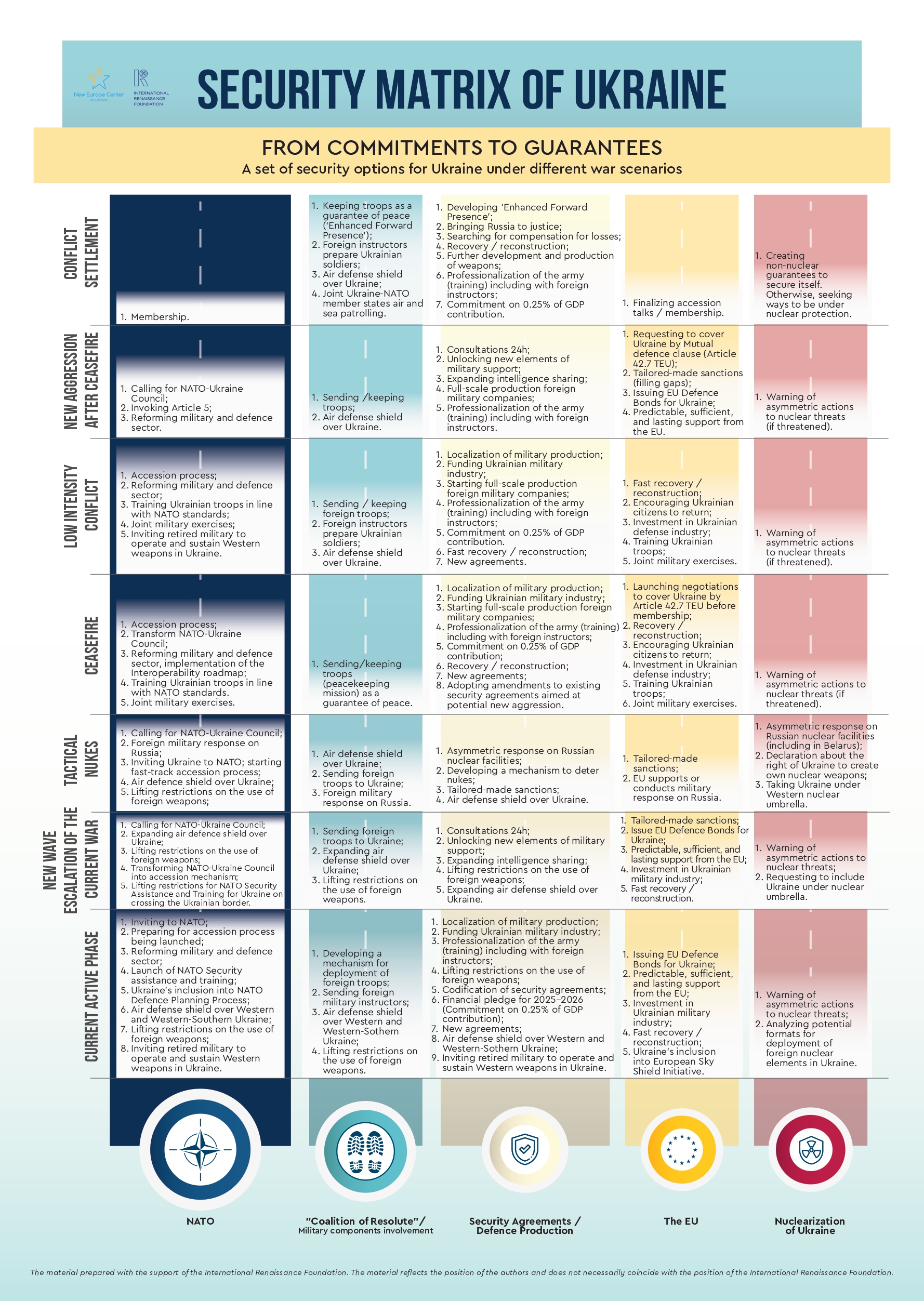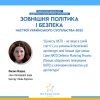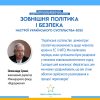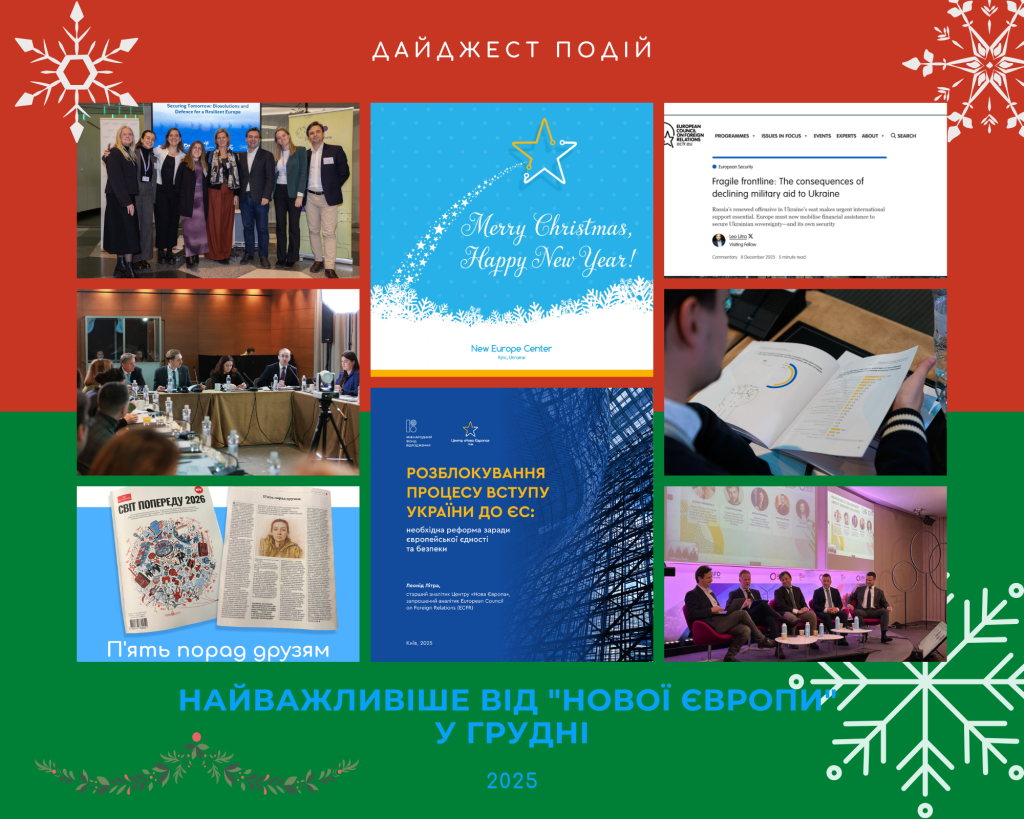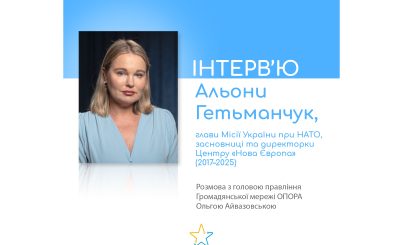Whatever the path to the end of war, for Ukraine, it must lie through security guarantees. This should be a fundamental condition from official Kyiv for any diplomatic scenario of war end, or even its potential halt. The New Europe Center team has been making every effort to ensure that Ukraine achieves the most effective security model — full membership in NATO (since the first relevant declaration of Ukraine in 2002). The invitation to join NATO and the start of the accession process even before the end of the war is our absolute priority. At the same time, we analyse other security formats that, although less effective, can play a role during the transitional phase, before joining the Alliance, and can be useful even after Ukraine becomes a member.
At the end of last year, New Europe Center, together with leading invited experts, published the results of a large-scale study ‘Security Formula ‘NATO Plus’[1], which, as reflected in the title, proposed a security model for Ukraine with a clear and immediate priority of joining NATO, but with the involvement of useful elements of other security models.
‘The Security Matrix, which you have the opportunity to read now, is another analytical material in a series of documents devoted to the study of various options for guaranteeing security — from weaker elements of an auxiliary nature (provision of weapons and equipment, military training, financial support, etc.) to solutions that include elements of collective defence (such as sending troops).
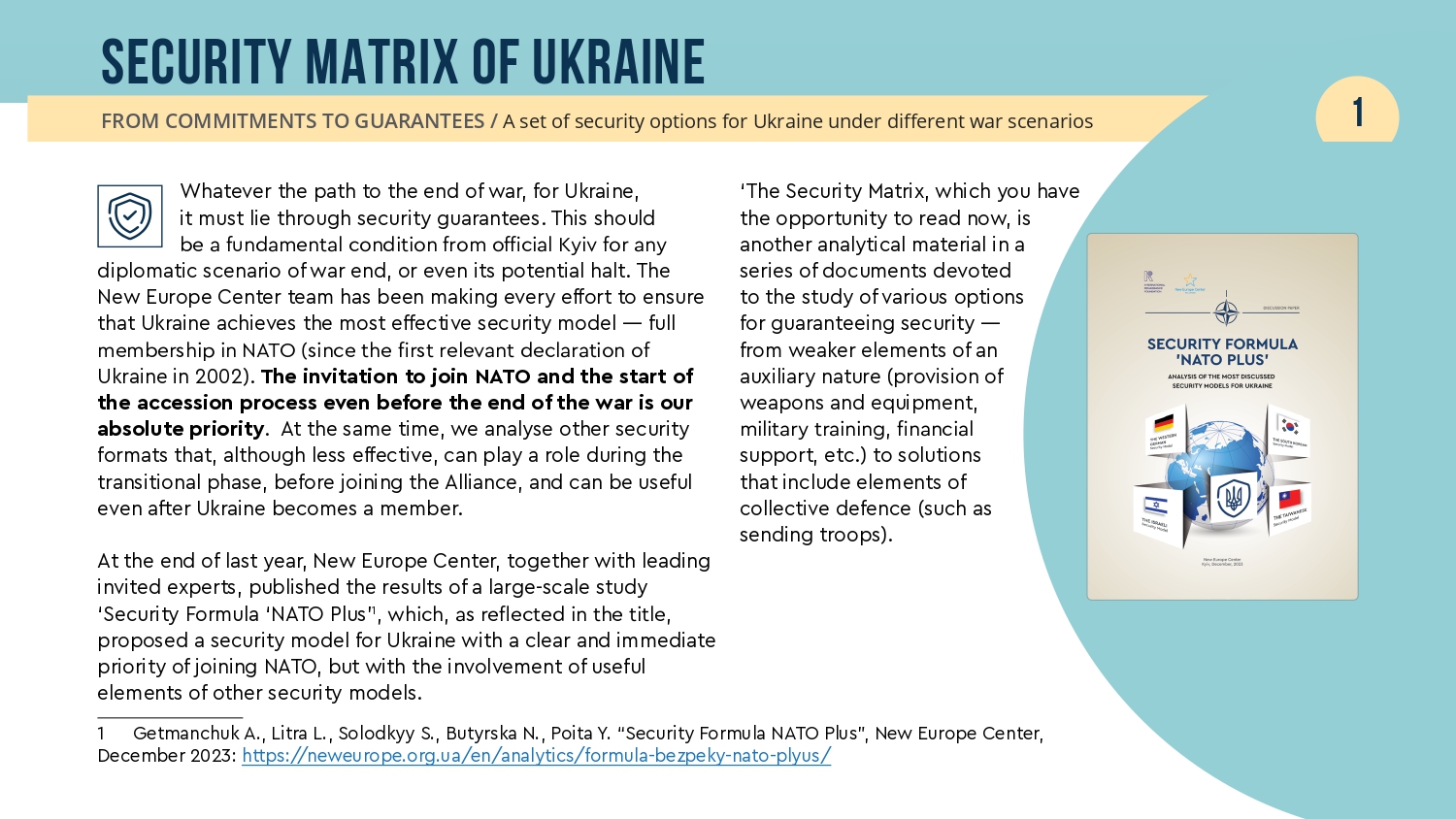
The purpose of this document is not to predict the development of events, but to suggest a set of security instruments for each of the possible stages of war. Including those that are generally considered unacceptable, undesirable, or unrealistic in Ukraine today (in particular, a temporary ceasefire/armistice or a nuclear tactical strike).
The document also offers a holistic view on different security elements. It aims to bring into the matrix security elements that are often disregarded in one part of the world and discussed in another one. Normalising the narrative about a new combination of security elements, such as ‘boots on the ground’, is essential to discussing security options that do not appear to be part of the primary response to Russian aggression.
Although the idea and development of the matrix belongs to the New Europe Center, leading experts, diplomats, and government officials from both Ukraine and abroad were involved in its discussion. Among the security instruments, we have deliberately included proposals that may look too ambitious or even unrealistic today. However, our team proceeds from the experience of the state: if Ukraine had defined its requirements and wishes for the West only on the basis of what was realistic, we would still have portable anti-tank systems.
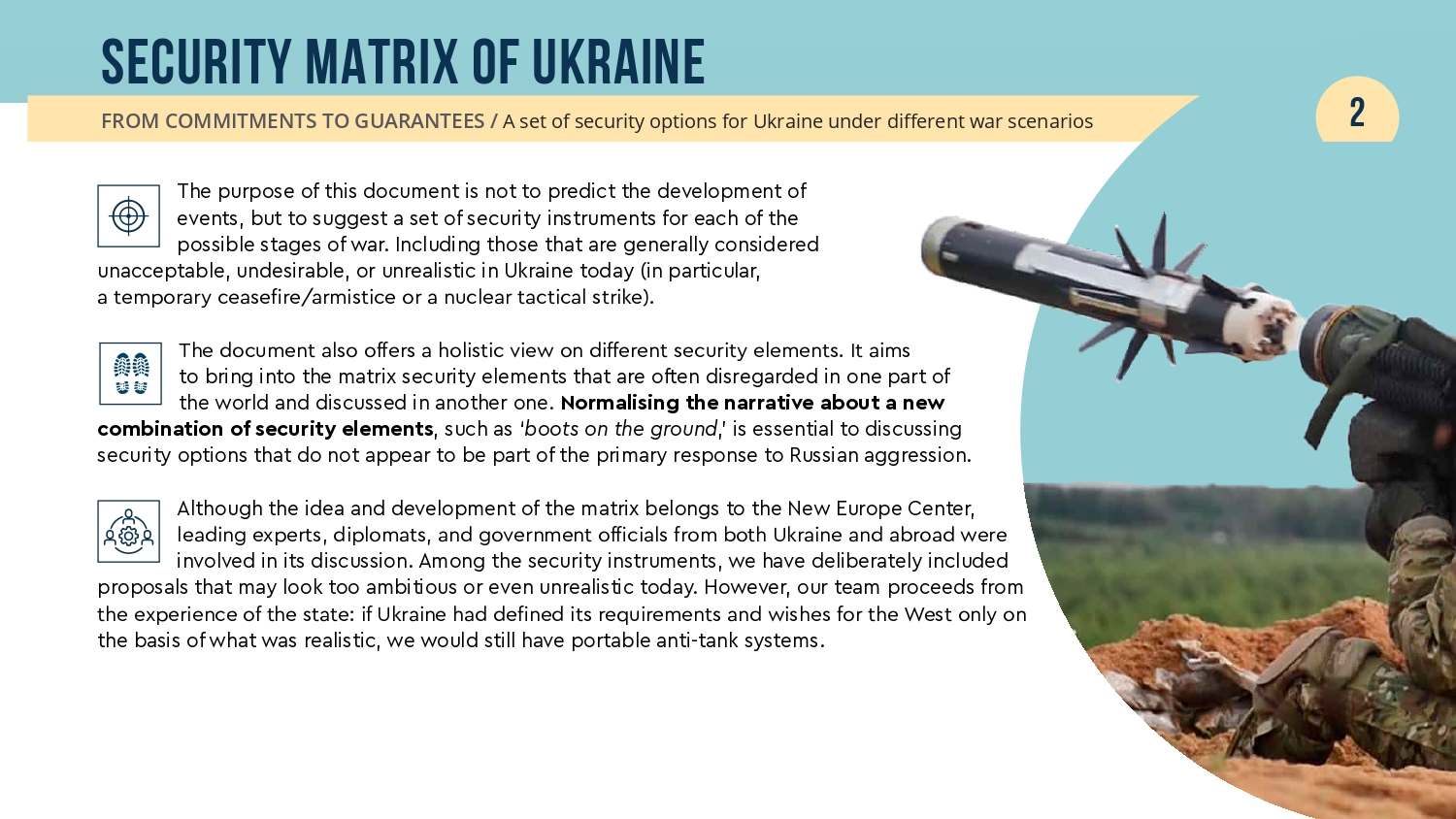
Therefore, one of the key goals of further diplomatic and expert work, in our opinion, should be to effectively fill and possibly institutionalise the ‘Coalition of Resolute’ — or rather, a coalition of countries willing to expand the options of how and, most importantly, for what purpose to help Ukraine, meaning not only to prevent its collapse as a state, but also to help it end the war in a way that most Ukrainians would perceive as a victory. We first came up with the initiative to form such a coalition in February 2024, supporting Emmanuel Macron’s idea to send partner troops to Ukraine[2].
The New Europe Center is convinced that there is no need to wait for the ‘post-victory’ period to start implementing security guarantees in the most common political interpretation, i.e. with the existing elements of collective defence. Some of these elements can and should be applied already at the stages of a possible ceasefire/ ‘truce’. That is why the enormous and unprecedented work on concluding security agreements (26 agreements at the time of preparation) should be complemented by work on unblocking Ukraine’s accession to NATO — if not immediate, then gradual, when the whole of Ukraine will be invited to join the Alliance within its internationally recognised borders, but Article 5 will gradually cover only the territories controlled by Kyiv (this is a significant difference from the partial accession or the West German model, when not only accession but also the invitation to NATO was addressed only to West Germany).
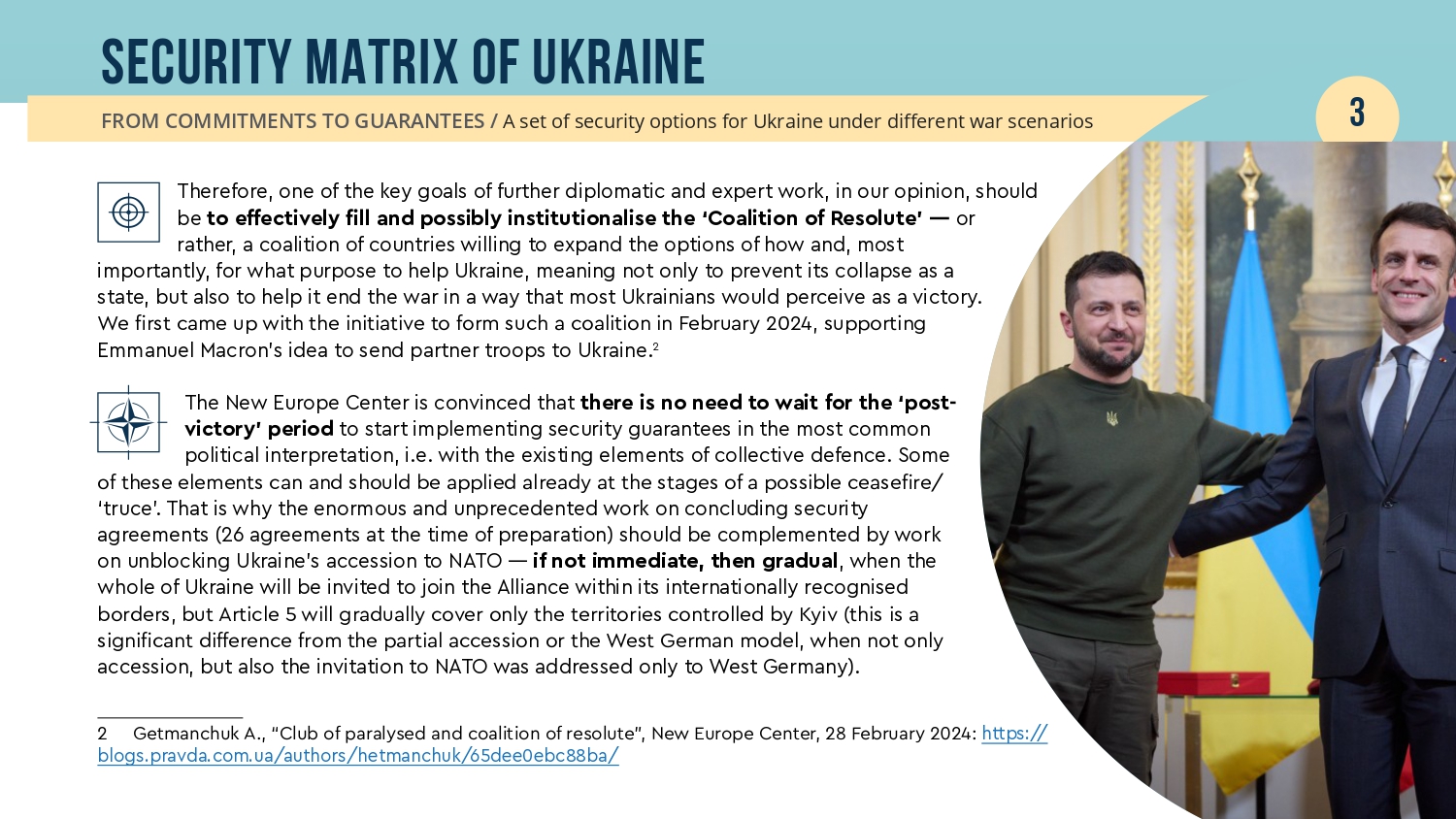
We continue to emphasise that it is time to fundamentally change Putin’s strategic calculation (that as long as the war continues, there is no chance for Ukraine to join the Alliance, so the war must continue). This can only be done by sending a clear political sign that, regardless of the situation on the battlefield and the percentage of territory occupied by Russia, NATO is considering inviting Ukraine to join the Alliance and starting the accession process with the appropriate application of Article 5 of the Washington Treaty.
An invitation to join NATO may take place even at the current stage of the active military phase — the New Europe Center with partners provided relevant recommendations to the Alliance before the NATO Summit in Vilnius in June 2023.[3] Despite the widespread perception, the invitation to join the Alliance does not have a clear list of preconditions, as is clearly stated in Article 7 of the NATO Enlargement Study, the document that has been the basis for the Alliance’s enlargement policy since 1995.
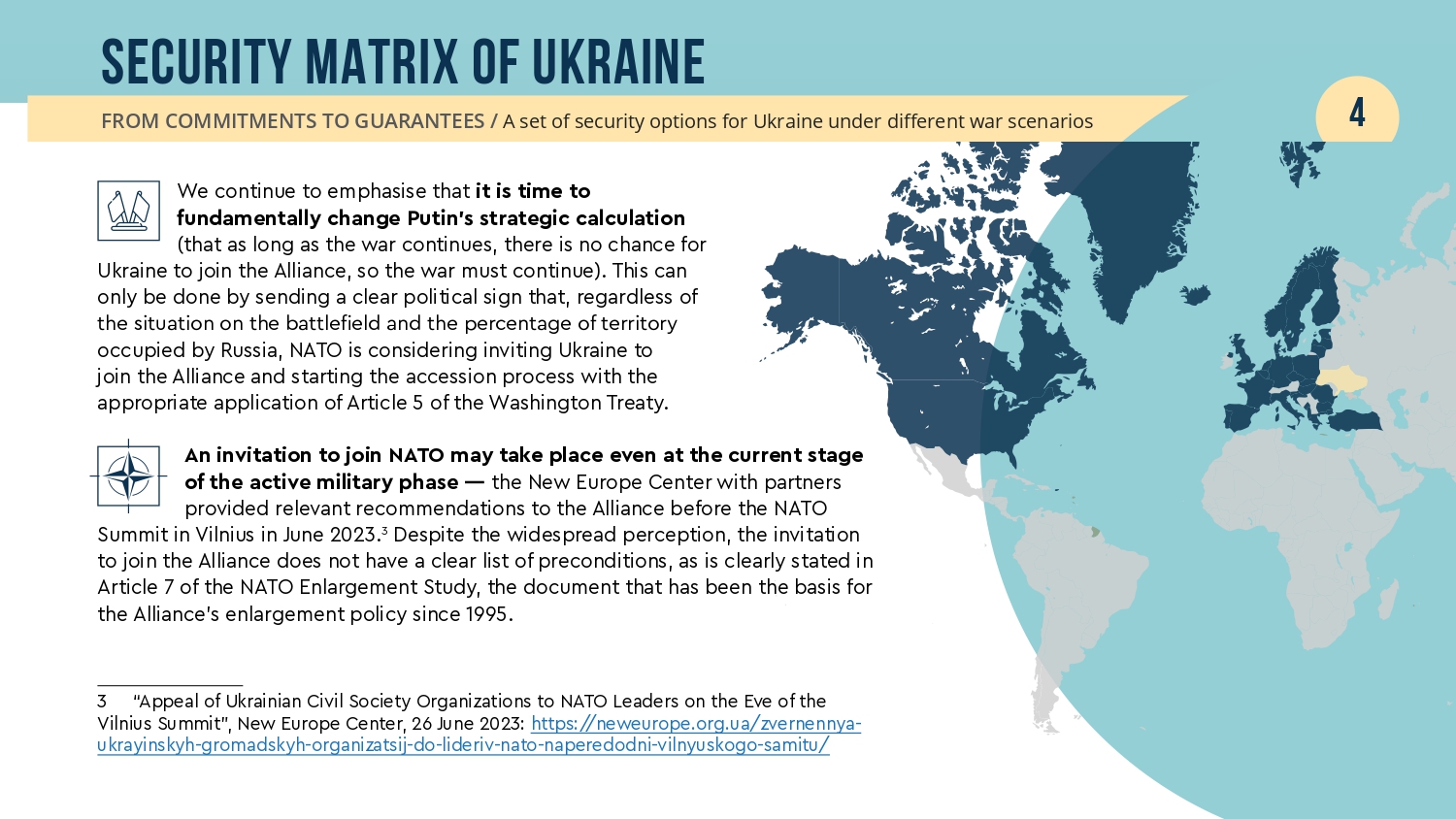
Since the Vilnius Summit, the need for an invitation decision has become even more apparent and urgent. At the same time, member states do not have to wait for the next summit to be invited to NATO — this issue can be decided in the ‘inter-summit’ period (the next summit of the Alliance will be held in The Hague (Netherlands) on 24-26 June 2025). In particular, before the end of US President Joe Biden’s term in office, as part of the formation of his presidential legacy in terms of Ukraine.
In parallel, there should be a thorough work on the implementation of the idea of a coalition of military instructors, which could eventually develop into a full-fledged military presence of Western troops on the territory of Ukraine. De facto, this could be a phased implementation of the Enhanced Forward Presence (eFP) model, which has been implemented in the Baltic States and Central European countries (permanent, albeit rotational, presence of member states’ troops on the territory of these countries since 2014 and beyond). The only difference is that both the eFP and the lighter version, which was initially implemented in Bulgaria, Romania, Slovakia, and Hungary — Tailored Forward Presence (tFP) — were and continue to be implemented under the auspices of NATO, while in the case of Ukraine, it may be a coalition of individual member states (as we classify it in the New Europe Center as the “Coalition of Resolute”).

Relatively speaking, if security agreements are considered as a bridge to genuine security guarantees, then we propose to move in parallel, where NATO becomes a first priority track, however, it can be used not at every stage of war. Foreign troops presence, with the relevant experience and capabilities in Ukraine, is a second track, but, if there is lack of consensus or proper leadership in NATO, or Alliance turned into a “sleeping mode” by United States (an idea, which could be implemented by Trump administration), this track may become as important as NATO accession. However, it will be hard to introduce not only during “active” phase of war, but also during ceasefire.
The experience of the Baltic States and Poland, which are NATO members, but are also subject to the Alliance’s Enhanced Forward Presence (eFP) programme, shows that even two such powerful security elements are not enough to feel secure. Therefore, it is crucial to develop our own defense production in parallel and enhance practical cooperation with the European Union in the defense sector, aiming to strengthen and at least partially apply Article 42.7 of the EU Treaty to both member states and EU candidate countries.
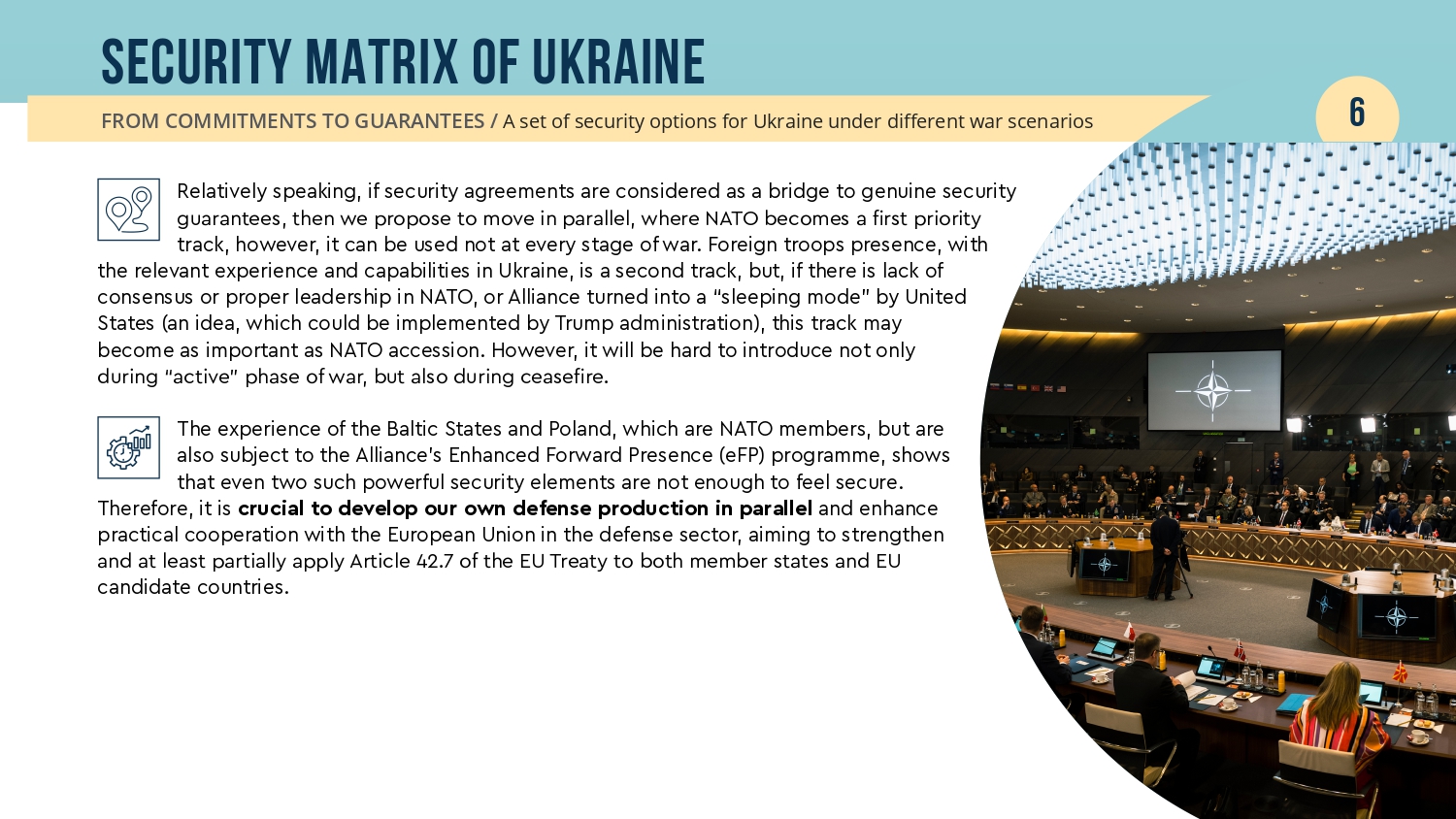
What security instruments can be used and at what stages of war? What elements of security guarantees should be implemented as early as the potential ceasefire, but before the de-occupation of all Ukrainian territories? At what stages can these security tracks be combined? To answer these critical questions, we need a helicopter view. We have tried to capture this view and offer a holistic picture in the form of visualised analysis. The result is a detailed table, where the horizontal vector represents different security instruments and routes (NATO, EU, security agreements, etc.), and the vertical axis represents different stages of the war (they are not in chronological order; some stages may be earlier and some later). The cells contain possible security solutions-options within a certain security vector at a certain stage of the war.
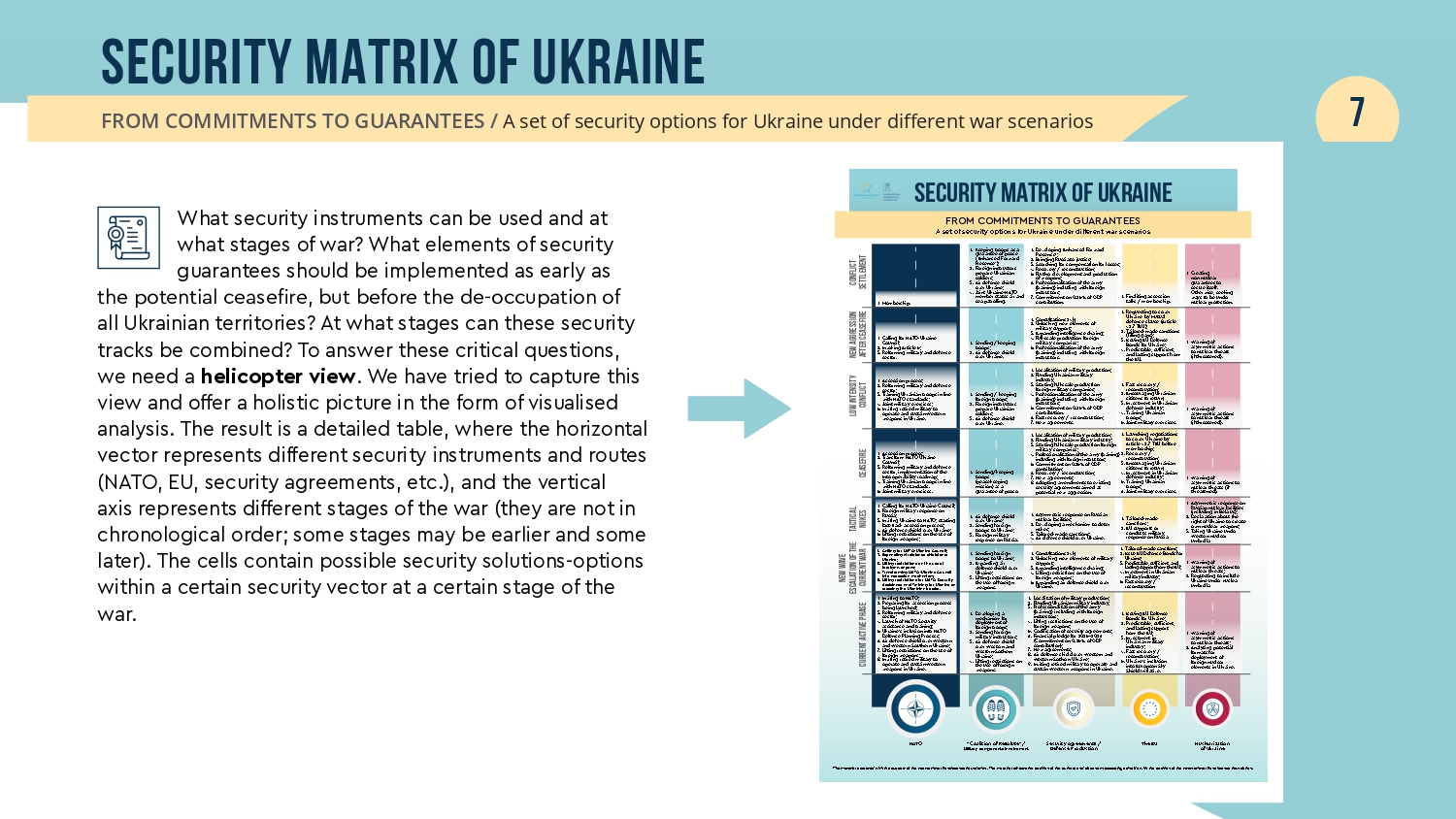
How to read the Security Matrix? For example, during the current active phase of the war, New Europe offers the following security options on the NATO track:
- Invitation to NATO;
- Preparing to launch the accession process being launched;
- Reforming military and defence sector;
- Launch of NATO Security assistance and training;
- Ukraine’s inclusion in NATO’s Defence Planning Process;
- Air defence shield over Western and Western-Southern Ukraine;
- Lifting restrictions on the use of foreign weapons;
- Inviting retired military personnel to operate and maintain Western weapons in Ukraine.
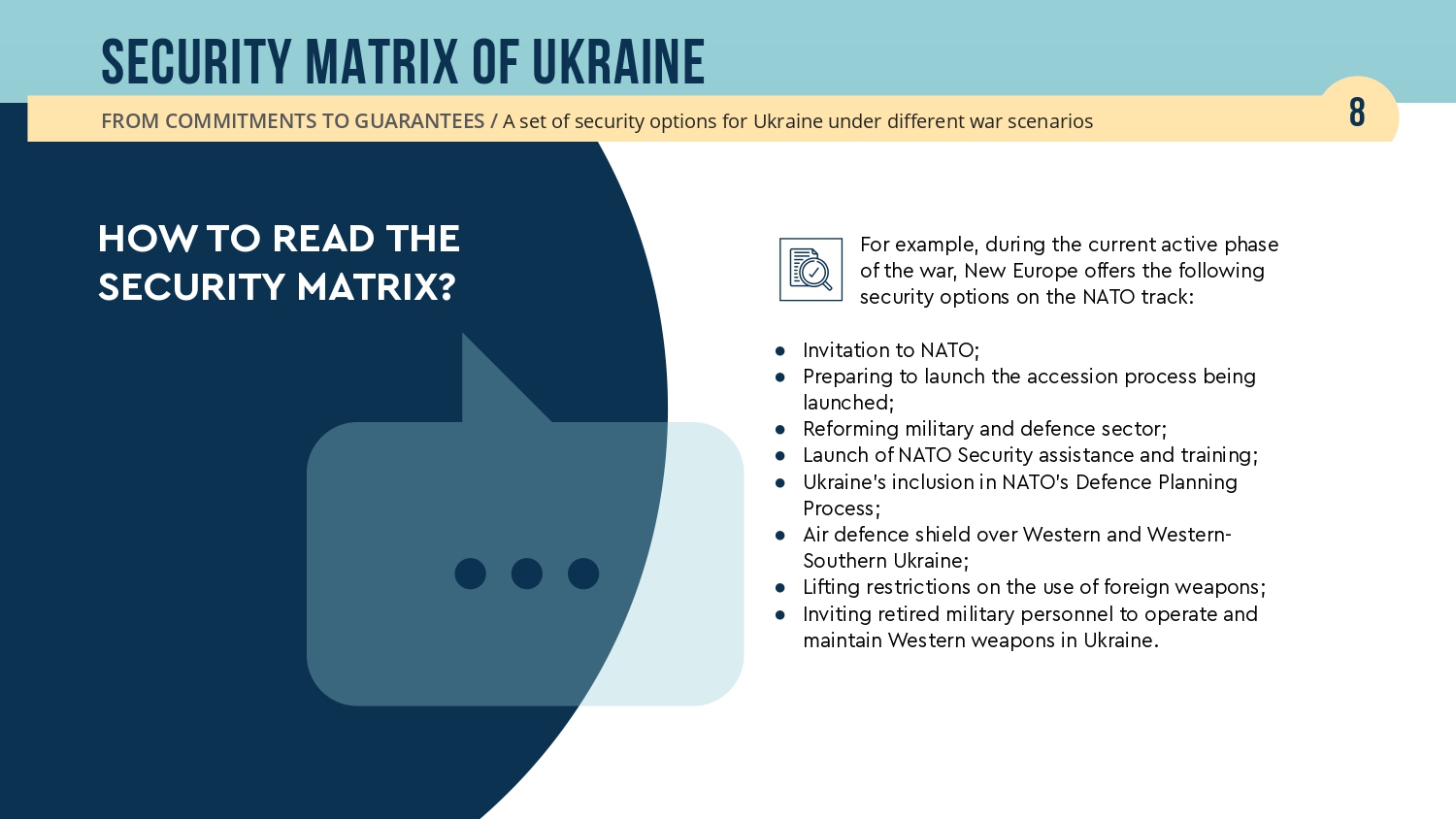
Some decisions are deliberately ambiguous and vague, and therefore may be implemented in a weaker form or in a more decisive one (given the circumstances). In particular, this applies to the proposal ‘Sending foreign troops to Ukraine’, where the weaker implementation is sending military instructors who would train Ukrainian soldiers and gain experience in direct communication in Ukraine, and the bolder one is sending military with a wider mandate that would allow them to perform combat missions. Ambiguity is also characteristic of the proposals in the Nuclearization section, given the particularly sensitive nature of the topic.
We are convinced that a detailed discussion and implementation of these security options, with synchronised work both inside and outside the country to implement different tracks, will not only prevent future aggressions, but will also help to end the current phase of the war on the most acceptable terms for Ukraine.
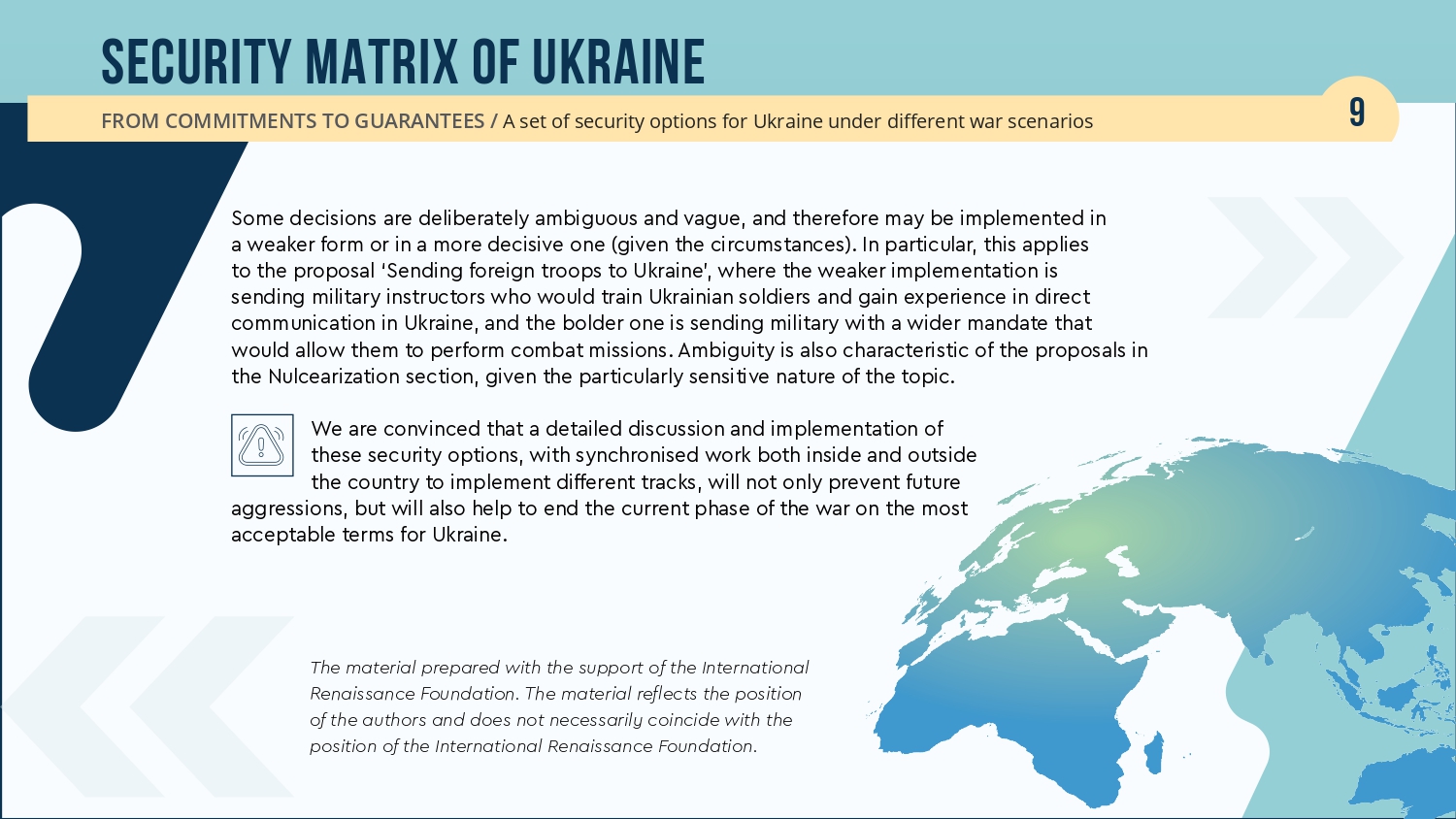
PDF-version of presentation is here.
The material prepared with the support of the International Renaissance Foundation. The material reflects the position of the authors and does not necessarily coincide with the position of the International Renaissance Foundation.
[1] Getmanchuk A., Litra L., Solodkyy S., Butyrska N., Poita Y. “Security Formula NATO Plus”, New Europe Center, December 2023: https://neweurope.org.ua/en/analytics/formula-bezpeky-nato-plyus/
[2] Getmanchuk A., “Club of paralysed and coalition of resolute”, New Europe Center, 28 February 2024: https://blogs.pravda.com.ua/authors/hetmanchuk/65dee0ebc88ba/
[3] “Appeal of Ukrainian Civil Society Organizations to NATO Leaders on the Eve of the Vilnius Summit”, New Europe Center, 26 June 2023: https://neweurope.org.ua/zvernennya-ukrayinskyh-gromadskyh-organizatsij-do-lideriv-nato-naperedodni-vilnyuskogo-samitu/



